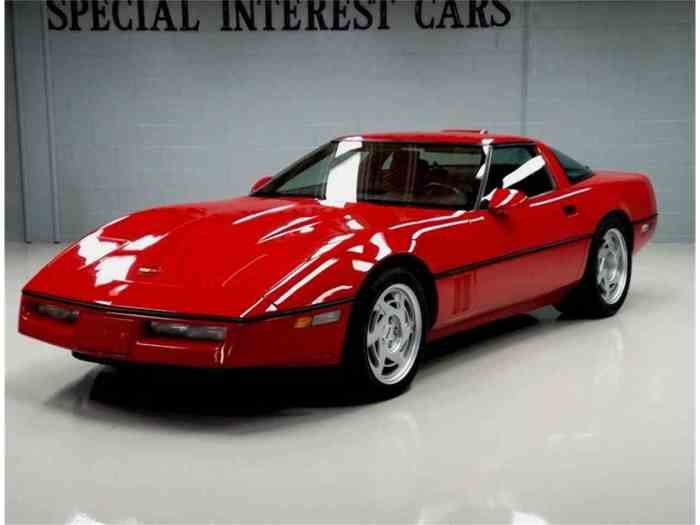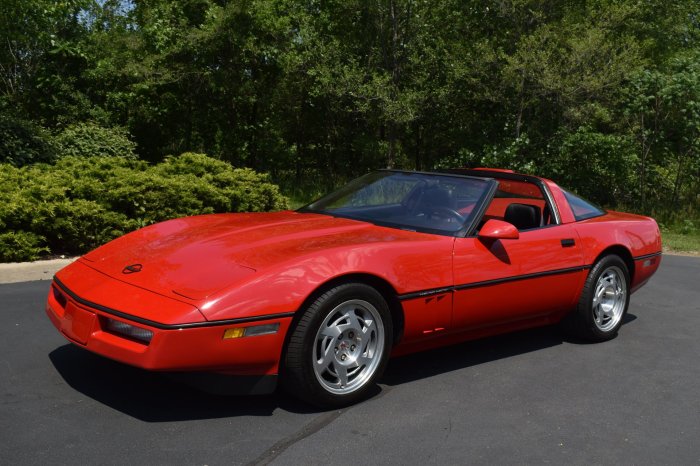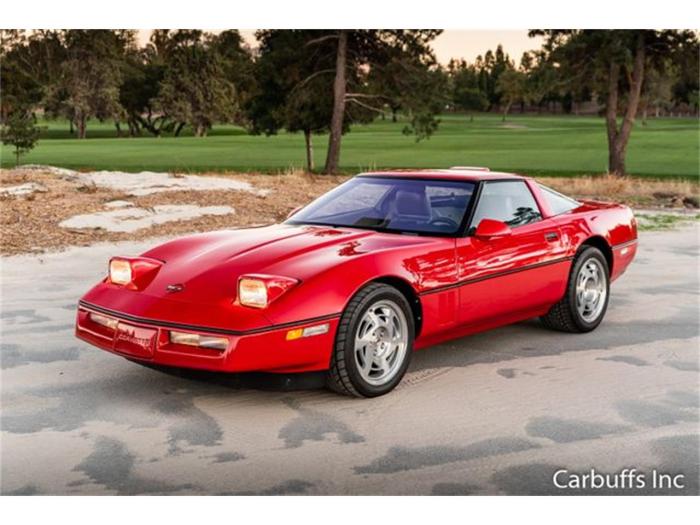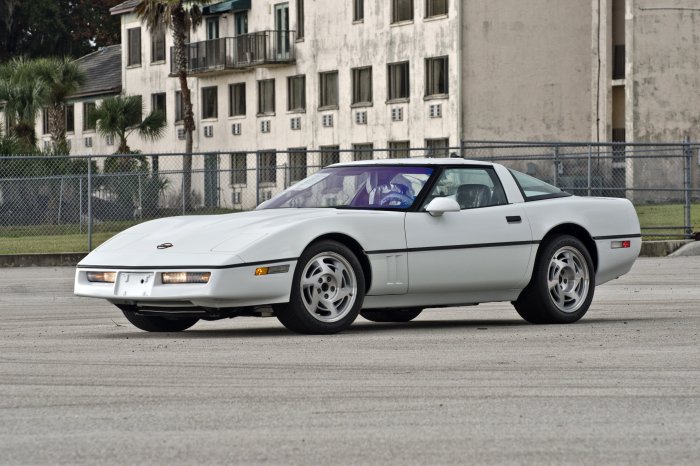The 1990 Chevrolet Corvette ZR1 stands as a testament to American automotive prowess, a high-performance masterpiece that redefined the Corvette’s legacy. This extraordinary machine, born from a desire to push the boundaries of speed and handling, arrived on the scene at a time when the automotive world was experiencing a surge of technological innovation.
Its arrival was not just a significant moment for Chevrolet, but a defining event for the entire sports car landscape.
The ZR1 was a radical departure from previous Corvette models, featuring a powerful, naturally aspirated 5.7-liter LT5 engine, a testament to the engineering prowess of Lotus, a British firm known for its expertise in lightweight, high-performance vehicles. The LT5, capable of generating an impressive 375 horsepower and 370 lb-ft of torque, propelled the ZR1 to remarkable speeds, solidifying its reputation as a true performance machine.
The 1990 Chevrolet Corvette ZR1: A Supercar Icon

The 1990 Chevrolet Corvette ZR1, often referred to as the “King of the Hill” Corvette, was a groundbreaking model that pushed the boundaries of American performance and cemented its place as a legend in Corvette history. It was the first Corvette to be officially designated as a ZR1, signifying its extreme performance capabilities and positioning it as a true supercar.
This model was introduced in an era where European supercars like the Ferrari Testarossa and Porsche 911 Turbo dominated the market, but the ZR1 aimed to challenge the status quo and prove that American engineering could compete with the best.
The ZR1’s Development and Significance
The 1990 Corvette ZR1’s development was a testament to General Motors’ commitment to pushing the limits of performance. The project began in the early 1980s when GM recognized the need for a higher-performance Corvette to compete with the growing European supercar market.
This led to the creation of a dedicated team of engineers and designers tasked with developing a truly exceptional Corvette. The ZR1’s development was also notable for its extensive use of Lotus Engineering, a British company known for its expertise in handling and lightweight construction.
Lotus’s involvement was crucial in shaping the ZR1’s handling and performance characteristics, making it a true driver’s car.
The 1990 Chevrolet Corvette ZR1, a technological marvel for its time, pushed the boundaries of performance with its 32-valve, 5.7-liter LT5 engine. It’s interesting to note that Chevrolet’s history with performance extends far beyond the ZR1, all the way back to the 1916 Chevrolet Touring , a model that helped establish the brand’s early reputation for reliable and stylish vehicles.
The 1990 ZR1, with its powerful engine and aerodynamic design, embodied the spirit of innovation that Chevrolet has consistently demonstrated throughout its history.
Design and Performance
The 1990 Chevrolet Corvette ZR1 was a groundbreaking performance car that pushed the boundaries of American automotive engineering. Its unique design and powerful engine made it a true supercar icon.
Design
The ZR1’s design was a radical departure from the standard Corvette. It featured a wide, aggressive body with a large rear wing and a prominent front spoiler. These aerodynamic enhancements were crucial for achieving the car’s impressive performance. The ZR1 also featured a distinctive “wide-body” design, which gave it a wider stance and improved stability at high speeds.
The 1990 Chevrolet Corvette ZR1 was a beast of a car, packing a powerful engine and a sleek design. While it was known for its performance, it wasn’t the only Chevrolet model that turned heads in the late 1980s.
The 1987 Chevrolet Silverado offered a different kind of appeal, with its rugged truck styling and reliable performance. However, for those seeking pure speed and adrenaline, the ZR1 remained the ultimate choice, a symbol of American muscle and engineering prowess.
Performance Specifications
The 1990 ZR1 was powered by a 5.7-liter LT5 engine, a hand-built, all-aluminum V8 with a unique design. The engine produced an impressive 375 horsepower and 370 lb-ft of torque. The ZR1’s engine was paired with a six-speed manual transmission, which allowed drivers to fully exploit the car’s power.
The LT5 engine was the most powerful engine ever offered in a Corvette at the time, and it helped the ZR1 achieve a top speed of 180 mph.
Handling and Driving Dynamics
The ZR1’s handling and driving dynamics were equally impressive. The car featured a sophisticated suspension system that provided excellent grip and stability. The ZR1’s wide tires and powerful brakes gave it incredible stopping power. The car’s lightweight construction and aerodynamic design further enhanced its handling and performance.
The 1990 Corvette ZR1 was a true supercar that could rival the best sports cars in the world.
Technical Innovations

The 1990 Chevrolet Corvette ZR1 was a technological marvel for its time, incorporating several groundbreaking innovations that pushed the boundaries of performance and handling. These advancements were not merely cosmetic but fundamentally altered the driving experience, making the ZR1 a true supercar.
Lotus-Developed Suspension
The ZR1’s suspension was meticulously engineered by Lotus, renowned for its expertise in handling and performance. This collaboration resulted in a sophisticated system featuring adjustable dampers, anti-roll bars, and a unique geometry that maximized grip and agility. The Lotus-tuned suspension provided precise feedback to the driver, allowing for confident cornering and exceptional control at high speeds.
Lightweight Aluminum Body Panels
To achieve its remarkable performance, the ZR1 required a lightweight design. Chevrolet employed extensive use of aluminum for the body panels, significantly reducing the car’s overall weight. This reduction in mass contributed to enhanced acceleration, braking, and handling, making the ZR1 a formidable performer on the track and on the road.
Powerful LT5 Engine
The heart of the ZR1 was its potent LT5 engine, a 5.7-liter, 32-valve, all-aluminum V8. This engine was a technological tour de force, featuring a unique dual-overhead camshaft design, a dry-sump lubrication system, and a high-flow intake manifold. The LT5 delivered an impressive 375 horsepower and 370 lb-ft of torque, making the ZR1 one of the most powerful production cars of its era.
High-Performance Goodyear Tires
To handle the immense power and grip of the ZR1, Chevrolet partnered with Goodyear to develop specialized high-performance tires. These tires featured a unique tread pattern and construction designed to provide maximum grip in both dry and wet conditions. The Goodyear tires played a crucial role in maximizing the ZR1’s handling capabilities, allowing for precise control and exceptional cornering performance.
Legacy and Impact

The 1990 Chevrolet Corvette ZR1, a technological marvel in its time, left an indelible mark on the automotive landscape. Its impact extends beyond its impressive performance and innovative engineering, shaping the Corvette’s future and inspiring generations of sports car enthusiasts.
Cultural and Historical Significance
The 1990 ZR1 was more than just a car; it was a cultural phenomenon. Its introduction coincided with a surge in American muscle car popularity, and it quickly became a symbol of American automotive prowess. It was featured in numerous magazines, TV shows, and movies, solidifying its status as a pop culture icon.
The ZR1’s distinctive design, with its wide body and aggressive styling, became instantly recognizable, captivating the imagination of car enthusiasts worldwide. Its performance, exceeding that of many European supercars of the time, challenged the notion that American cars were inferior in terms of handling and speed.
Impact on the Corvette Model Line
The ZR1’s success had a profound impact on the Corvette model line. Its introduction signaled a shift in the Corvette’s focus, moving beyond its traditional role as a sporty coupe to a more performance-oriented approach. The ZR1’s advanced technologies, including its lightweight composite body and powerful LT5 engine, paved the way for future Corvette models to embrace cutting-edge engineering.
Subsequent generations of Corvettes incorporated many of the design and engineering principles pioneered by the ZR1, resulting in a more powerful and capable lineup.
The Lasting Legacy
The 1990 ZR1 remains a coveted collectible today, with its rarity and historical significance driving its value. Its legacy lives on in the hearts of car enthusiasts, inspiring a new generation of Corvette fans. The ZR1’s influence on the Corvette model line is undeniable, shaping its evolution and pushing the boundaries of performance.
The ZR1’s impact on the world of sports cars is undeniable, inspiring other manufacturers to develop high-performance models that challenge the status quo.
Ownership and Maintenance
Owning a 1990 Chevrolet Corvette ZR1 is a unique and rewarding experience, but it comes with certain considerations. The car’s high-performance nature and specialized components require a dedicated approach to maintenance and ownership. This section will delve into the financial implications, acquisition process, and resources available for maintaining this iconic supercar.
The 1990 Chevrolet Corvette ZR1, with its powerful LT5 engine and aggressive styling, represented the pinnacle of American performance cars in its time. While it was a far cry from the classic elegance of a 1930 Chevrolet Roadster , both vehicles shared a common thread: the embodiment of Chevrolet’s dedication to innovation and pushing the boundaries of automotive engineering.
The ZR1, with its advanced technology and performance, was a testament to Chevrolet’s commitment to evolving with the times, while the Roadster, with its timeless design and craftsmanship, represented a legacy of American automotive heritage.
Cost of Ownership
The cost of owning a 1990 ZR1 can vary significantly depending on the condition of the car, its mileage, and the owner’s maintenance practices. The initial purchase price for a well-maintained example can range from $50,000 to $100,000, or even higher for rare or exceptional specimens.
- Maintenance Costs: The ZR1’s powerful engine and advanced technology require regular servicing and specialized parts. Expect to spend a significant amount on routine maintenance, such as oil changes, brake pad replacements, and tire rotations.
- Repair Expenses: Due to its complex design, repairs can be costly. Finding qualified mechanics familiar with the ZR1 is crucial, and parts may be difficult to source and expensive to replace.
- Insurance: As a high-performance vehicle, insurance premiums for a 1990 ZR1 are likely to be higher than for a standard car.
Acquiring a 1990 ZR1
Finding a well-maintained 1990 ZR1 requires careful research and due diligence. Here’s a guide for potential owners:
- Thorough Inspection: Have a qualified mechanic inspect the car thoroughly before purchase. Look for signs of rust, damage, or modifications that may indicate poor maintenance or past accidents.
- Service History: Request the car’s service history to assess its maintenance record. Look for consistent servicing at reputable shops.
- Online Resources: Utilize online resources like forums, classifieds, and enthusiast groups to connect with other ZR1 owners and gather information about available cars.
- Professional Inspections: Consider hiring a professional inspection service for a comprehensive evaluation of the car’s condition.
Parts and Resources, 1990 Chevrolet Corvette ZR1
While the 1990 ZR1 is a classic car, parts and resources are still available for maintaining and restoring these vehicles.
- Specialists: Several specialized shops and online retailers cater to Corvette enthusiasts, offering parts, restoration services, and technical support.
- Online Forums: Online forums dedicated to the Corvette ZR1 provide a platform for owners to share information, find parts, and seek advice from experienced individuals.
- Vintage Parts Suppliers: Some vintage parts suppliers specialize in sourcing hard-to-find components for classic cars, including the ZR1.
- Manufacturer Support: While Chevrolet no longer directly supports the 1990 ZR1, some parts may still be available through official channels.
Collector’s Value and Market Trends: 1990 Chevrolet Corvette ZR1

The 1990 Chevrolet Corvette ZR1, a legendary supercar, has become a coveted collectible among automotive enthusiasts. Its limited production, exceptional performance, and historical significance have contributed to its rising value over the years. Understanding the factors that influence the ZR1’s market value and its potential for future appreciation is crucial for collectors and investors alike.
Factors Influencing the Value of 1990 ZR1s
The value of a 1990 ZR1 is influenced by several key factors, including:
- Condition:The overall condition of the car, including its paint, interior, engine, and drivetrain, plays a significant role in its value. Well-maintained and original examples with low mileage command the highest prices.
- Mileage:Lower mileage ZR1s are generally more desirable and command higher values. This is because they have experienced less wear and tear, and are likely to have been better cared for.
- Options:Certain options, such as the optional adjustable suspension, were not available on all ZR1s. These options can significantly impact the car’s value, especially if they are rare or desirable.
- Documentation:Original documentation, including the owner’s manual, service records, and build sheet, can add value to a ZR1. These documents provide a history of the car and help to verify its authenticity.
- Rarity:The 1990 ZR1 was produced in limited numbers, making it a rare and sought-after car. Rare color combinations or special edition models are particularly valuable.
- Historical Significance:The 1990 ZR1 holds a significant place in automotive history as the first American supercar to be equipped with a supercharged engine. This historical significance contributes to its value.
- Market Demand:The demand for 1990 ZR1s is driven by factors such as collector interest, economic conditions, and media attention. Strong demand can lead to higher prices, while weak demand can result in lower values.
Potential for Future Appreciation
The future value of the 1990 ZR1 is difficult to predict with certainty. However, several factors suggest that the car has the potential for continued appreciation:
- Limited Production:With only 3,000 units produced, the 1990 ZR1 remains a rare car. This scarcity is likely to continue to drive demand and support its value.
- Growing Collector Interest:The popularity of classic cars, particularly those with performance heritage, is on the rise. As the 1990 ZR1 becomes more collectible, its value is likely to increase.
- Historical Significance:The ZR1’s place in automotive history is secure. As time passes, its historical significance is likely to become even more pronounced, further enhancing its value.
- Strong Performance:The ZR1’s exceptional performance, both in its time and even by today’s standards, continues to be admired. This performance legacy is a major factor contributing to its value.
Concluding Remarks

The 1990 Chevrolet Corvette ZR1 left an enduring mark on the automotive world, a symbol of American engineering ingenuity and a benchmark for performance. Its legacy continues to inspire car enthusiasts and collectors, reminding us of the power of innovation and the pursuit of automotive excellence.
The ZR1 remains a testament to the spirit of the Corvette, a car that has consistently pushed the limits of what’s possible on the road.